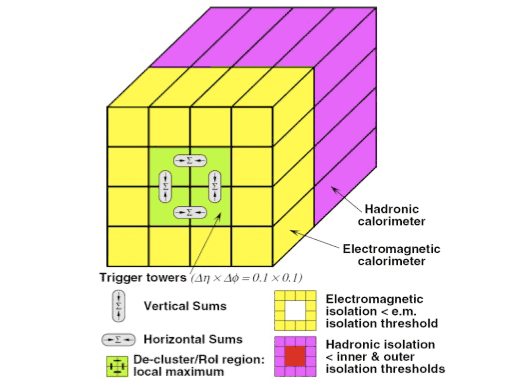
ATLAS e-News
23 February 2011
Un, deux, tau: trigger!
27 July 2009
The presence of leptons in the final state is one of the most powerful handles to select interesting events from the overwhelming background of QCD events at the LHC. The first two generations, the electron and the muon, leave very distinct signatures in the ATLAS detector, which are exploited for efficient event selection both at the trigger level and in offline analyses. Even though, from a physics point of view, the third generation lepton is at least as interesting as its two lighter sisters, the tau lepton generally receives less attention.
With a mass of 1.777 GeV, the tau has a relatively short lifetime (c*tau = 87 microns) and hence decays inside the beam pipe. About 35% of all taus decay fully leptonically to an electron or a muon and two neutrinos. Experimentally these decays have the same signatures as directly produced electrons or muons except that on average two thirds of the energy is carried away by undetected neutrinos. Thus, depending on the applied energy threshold, a fraction of these decays will be selected by the electron and muon triggers.
When discussing tau leptons at the LHC, one is most often implicitly referring to the remaining 65%, which decay to a hadronic system and one neutrino. Being constrained by the tau mass, the hadronic system has a relatively low multiplicity of either one (50%) or three (15%) charged particles possibly accompanied by one or more neutral pions. At LHC energies, the hadronic system (often referred to as the tau jet) is highly collimated. Low multiplicity and high collimation are the two distinctive features that allow their separation from QCD jets.
The ATLAS trigger system comprises three levels of event selection: The hardware-based Level 1 (L1) and the software-based Level 2 (L2) and Event Filter (EF). Collectively, L2 and EF are referred to as the High Level Trigger (HLT). At L1, the calorimeter data is grouped into trigger towers of granularity 0.1 x 0.1 in η x φ space. Whereas QCD jets are selected by applying an energy threshold in relatively large regions of 8 x 8 towers, the philosophy for tau jets is somewhat different. Narrower search regions of 4 x 4 towers are logically divided into the 2 x 2 central core and the surrounding 12 towers of the isolation ring. Highly collimated jets can be selected by applying a threshold on the energy in the central core combined with a ceiling on the energy in the isolation ring. Even though this would provide a perfectly valid tau trigger, a variation of this scheme has been chosen, by excluding from the energy calculation in the electromagnetic part of the central core the two least energetic neighbouring towers. This scheme results in a somewhat degraded energy resolution compared to the full 2 x 2 central core; however, the separation between tau and QCD jets has been found to be better. This scheme is illustrated below.

The L1 tau trigger: The candidate energy is calculated from the 2x2 core (red) in the hadronic calorimeter and the highest of the four sums in the core (green) of the electromagnetic calorimeter.
The L2 selection is based on the Region of Interest (RoI) concept, where the algorithm accesses data from a limited geometrical region centred at the L1 candidate position. At EF, again the RoI concept is exploited in order to reduce the execution time. Full granularity tracker and calorimeter data is available at the HLT. At L2, where algorithm execution time is limited, simplified reconstruction algorithms are employed. The EF selection, on the other hand, is based on the offline tau reconstruction algorithm (tauRec). At both levels, important features for the candidate selection include the track multiplicity, the collimation and isolation of tracks as well as calorimeter energy depositions, and the matching between the tracks and the calorimeter showers.
A number of single tau signatures with different transverse energy thresholds has been defined as basic elements of the tau trigger. At a typical working point, hadronic tau decays with energy above threshold are selected with 60% efficiency, and the background of QCD jets is reduced by about two orders of magnitude.

Expected L1 trigger rate at a luminosity of 1031 cm-2 s-1 as function of the transverse energy threshold. Rates are shown without and with an isolation requirement of 6 GeV in the electromagnetic calorimeter.
Simulation studies have shown that even at an initial luminosity of 1031 cm-2s-1, it is necessary to apply a transverse energy threshold of at least 50 GeV in order for the single tau signature to stay within the available bandwidth. It is therefore necessary to combine the tau signature with other event features. Events containing tau pairs, possibly from Z or Higgs decays, are effectively selected by combining a single tau signature with an electron or muon signature or with a second tau signature. Events containing only a single tau, possibly from a W or a charged Higgs decay, are selected by combining a tau signature with the presence of missing transverse energy. Trigger items combining tau and jet signatures have been also designed. These are mainly aiming for tau decays in more complicated topologies such as SUSY or ttbar events.
The first experience with the operation of the tau trigger was gathered during last year's cosmic run. Even though technically successful, clearly no real taus were observed but at least the trigger rate was inside acceptable limits! Like everybody else, the tau trigger group is eagerly awaiting beam data. The first evaluation of the tau trigger performance will be made on low multiplicity QCD jets that pass the offline selection criteria for a hadronic tau decay.
A recent, more complete description of the ATLAS tau trigger can be found in the trigger section of our large CSC book.

Mogens DamNiels Bohr Institute
|